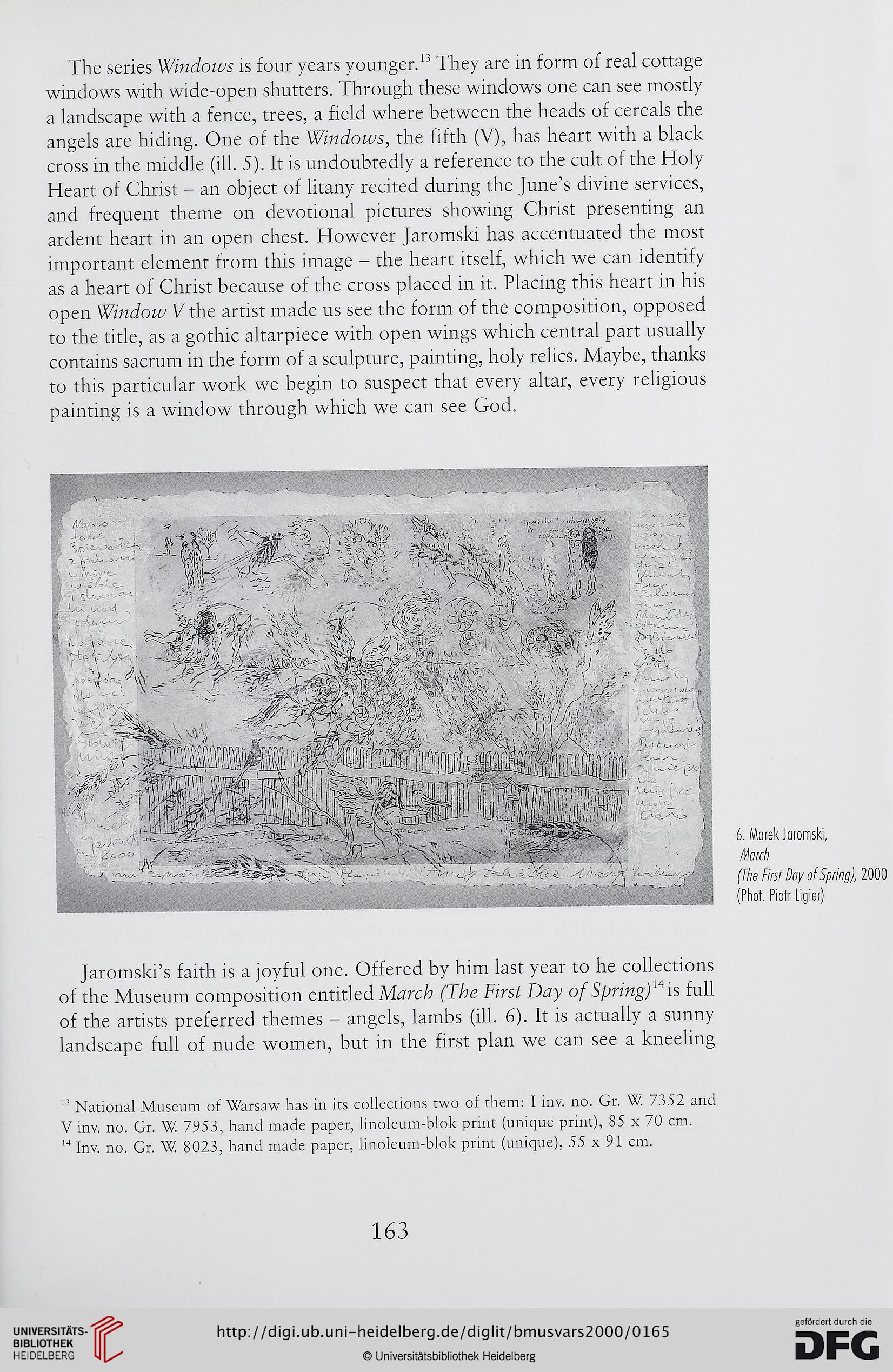The series Windows is four years younger.1 ’ They are in form of real cottage
Windows with wide-open shutters. Through these Windows one can see mostly
a landscape with a fence, trees, a field where between the heads of cereals the
angels are hiding. One of the Windows, the fifth (V), has heart with a black
cross in the middle (ill. 5). It is undoubtedly a reference to the cult of the Holy
Heart of Christ - an object of litany recited during the June’s divine services,
and freąuent theme on devotional pictures showing Christ presenting an
ardent heart in an open chest. However Jaromski has accentuated the most
important element from this image - the heart itself, which we can identify
as a heart of Christ because of the cross placed in it. Placing this heart in his
open Window V the artist madę us see the form of the composition, opposed
to the title, as a gothic altarpiece with open wings which central part usually
contains sacrum in the form of a sculpture, painting, holy relics. Maybe, thanks
to this particular work we begin to suspect that every altar, every religious
painting is a window through which we can see God.
-\'qJFc c
- :T-T
' |' Ą . b
1 '■7 ■: 7
6. Marek Jaromski,
March
(The First Day of Spring), 2000
(Phot. Piotr Ugier)
Jaromski’s faith is a joyful one. Offered by him last year to he collections
of the Museum composition entitled March (The First Day of Spring)14 is fuli
of the artists preferred themes - angels, lambs (ill. 6). It is actually a sunny
landscape fuli of nudę women, but in the first plan we can see a kneeling
13 National Museum of Warsaw has in its collections two of them: I inv. no. Gr. W. 7352 and
V inv. no. Gr. W 7953, hand madę paper, linoleum-blok print (uniąue print), 85 x 70 cm.
14 Inv. no. Gr. W. 8023, hand madę paper, linoleum-blok print (uniąue), 55 x 91 cm.
163
Windows with wide-open shutters. Through these Windows one can see mostly
a landscape with a fence, trees, a field where between the heads of cereals the
angels are hiding. One of the Windows, the fifth (V), has heart with a black
cross in the middle (ill. 5). It is undoubtedly a reference to the cult of the Holy
Heart of Christ - an object of litany recited during the June’s divine services,
and freąuent theme on devotional pictures showing Christ presenting an
ardent heart in an open chest. However Jaromski has accentuated the most
important element from this image - the heart itself, which we can identify
as a heart of Christ because of the cross placed in it. Placing this heart in his
open Window V the artist madę us see the form of the composition, opposed
to the title, as a gothic altarpiece with open wings which central part usually
contains sacrum in the form of a sculpture, painting, holy relics. Maybe, thanks
to this particular work we begin to suspect that every altar, every religious
painting is a window through which we can see God.
-\'qJFc c
- :T-T
' |' Ą . b
1 '■7 ■: 7
6. Marek Jaromski,
March
(The First Day of Spring), 2000
(Phot. Piotr Ugier)
Jaromski’s faith is a joyful one. Offered by him last year to he collections
of the Museum composition entitled March (The First Day of Spring)14 is fuli
of the artists preferred themes - angels, lambs (ill. 6). It is actually a sunny
landscape fuli of nudę women, but in the first plan we can see a kneeling
13 National Museum of Warsaw has in its collections two of them: I inv. no. Gr. W. 7352 and
V inv. no. Gr. W 7953, hand madę paper, linoleum-blok print (uniąue print), 85 x 70 cm.
14 Inv. no. Gr. W. 8023, hand madę paper, linoleum-blok print (uniąue), 55 x 91 cm.
163




